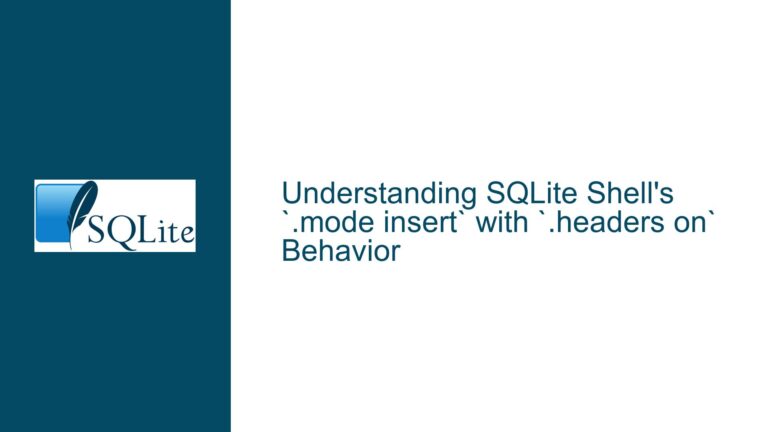Importing XML-Wrapped vCard Contacts into SQLite Database
Understanding the XML-Wrapped vCard Structure and Its Challenges
The core issue revolves around importing a list of contacts stored in an XML-wrapped vCard format into a SQLite database. The XML structure contains multiple <contact> blocks, each encapsulating a vCard entry. A typical vCard entry includes fields such as N (name), FN (full name), and TEL (telephone number), with some entries containing additional fields like TEL;WORK or NOTE. The challenge lies in parsing this nested structure—XML wrapping vCard—and transforming it into a format suitable for SQLite insertion.
The XML structure provided in the discussion is as follows:
<contact lookup="0r193-1612141412181224161214141218">
BEGIN:VCARD
VERSION:2.1
N:;Name;;;
FN:Full Name
TEL;CELL:0123456789
END:VCARD
</contact>
Each <contact> block contains a vCard entry, which is a plain text format for representing contact information. The vCard format uses a key-value structure, with each line representing a field. For example, N:;Name;;; represents the name field, and TEL;CELL:0123456789 represents a cell phone number.
The primary challenge is the dual-layer structure: the outer XML layer and the inner vCard layer. This nesting complicates direct parsing and insertion into SQLite, as it requires handling both XML and vCard formats simultaneously. Additionally, the presence of optional fields like TEL;WORK and NOTE introduces variability in the data structure, making it harder to define a fixed schema for the SQLite table.
Potential Causes of Parsing and Import Difficulties
The difficulties in parsing and importing the XML-wrapped vCard data into SQLite can be attributed to several factors:
Nested Data Formats: The data is stored in two nested formats—XML and vCard. XML is a markup language designed to store and transport data, while vCard is a plain text format for contact information. Parsing requires handling both formats, which increases complexity.
Variable Field Structure: The vCard format allows for optional fields, such as
TEL;WORKandNOTE. This variability means that not all contacts will have the same fields, making it challenging to define a consistent SQLite table schema.Lack of Direct SQLite Support for XML and vCard: SQLite does not natively support XML or vCard parsing. While SQLite has robust support for JSON, it lacks built-in functions for handling XML or vCard formats, necessitating the use of external tools or extensions.
Data Volume and Performance: The dataset contains 5,123 contact blocks. Processing such a large volume of data requires efficient parsing and insertion mechanisms to avoid performance bottlenecks.
Manual Parsing Risks: The initial suggestion of using find-and-replace operations to generate SQL
INSERTstatements is error-prone. Manual parsing can lead to data corruption, especially with nested and variable structures.
Step-by-Step Troubleshooting, Solutions, and Fixes
To address the challenges of importing XML-wrapped vCard contacts into SQLite, follow these detailed steps:
Step 1: Preprocess the XML Data
Before importing the data into SQLite, preprocess the XML to extract the vCard entries. This step involves parsing the XML to isolate each <contact> block and extract the embedded vCard data.
Use an XML Parser: Utilize an XML parser to read the XML file and extract the
<contact>blocks. Python’sxml.etree.ElementTreemodule is a suitable choice for this task. Here’s an example:import xml.etree.ElementTree as ET tree = ET.parse('contacts.xml') root = tree.getroot() for contact in root.findall('contact'): vcard_data = contact.text.strip() # Process vcard_data furtherExtract vCard Entries: Once the
<contact>blocks are extracted, isolate the vCard data. Each block contains a vCard entry that needs to be parsed separately.
Step 2: Parse the vCard Data
After extracting the vCard entries, parse them to extract individual fields such as N, FN, and TEL.
Use a vCard Parser: Leverage a vCard parsing library to handle the vCard format. Python’s
vobjectlibrary is a good option. Here’s how to use it:import vobject def parse_vcard(vcard_data): vcard = vobject.readOne(vcard_data) name = vcard.n.value if hasattr(vcard, 'n') else None full_name = vcard.fn.value if hasattr(vcard, 'fn') else None tel = vcard.tel.value if hasattr(vcard, 'tel') else None return name, full_name, telHandle Optional Fields: Account for optional fields like
TEL;WORKandNOTEby checking their presence before accessing their values. For example:work_tel = vcard.tel_list[0].value if hasattr(vcard, 'tel_list') else None note = vcard.note.value if hasattr(vcard, 'note') else None
Step 3: Transform Data into SQLite-Compatible Format
Once the vCard data is parsed, transform it into a format suitable for SQLite insertion.
Define the SQLite Table Schema: Create a table schema that accommodates all possible fields. For example:
CREATE TABLE contacts ( id INTEGER PRIMARY KEY AUTOINCREMENT, name TEXT, full_name TEXT, tel TEXT, work_tel TEXT, note TEXT );Generate SQL INSERT Statements: Convert the parsed data into SQL
INSERTstatements. For example:def generate_insert_statement(name, full_name, tel, work_tel, note): return f"INSERT INTO contacts (name, full_name, tel, work_tel, note) VALUES ('{name}', '{full_name}', '{tel}', '{work_tel}', '{note}');"
Step 4: Import Data into SQLite
With the SQL INSERT statements ready, import the data into the SQLite database.
Execute SQL Statements: Use SQLite’s
sqlite3module in Python to execute theINSERTstatements. Here’s an example:import sqlite3 conn = sqlite3.connect('contacts.db') cursor = conn.cursor() for contact in root.findall('contact'): vcard_data = contact.text.strip() name, full_name, tel = parse_vcard(vcard_data) insert_stmt = generate_insert_statement(name, full_name, tel, work_tel, note) cursor.execute(insert_stmt) conn.commit() conn.close()Optimize Performance: For large datasets, consider using transactions to batch
INSERTstatements and improve performance. For example:conn = sqlite3.connect('contacts.db') cursor = conn.cursor() cursor.execute('BEGIN TRANSACTION') for contact in root.findall('contact'): vcard_data = contact.text.strip() name, full_name, tel = parse_vcard(vcard_data) insert_stmt = generate_insert_statement(name, full_name, tel, work_tel, note) cursor.execute(insert_stmt) cursor.execute('COMMIT') conn.close()
Step 5: Validate and Verify the Imported Data
After importing the data, validate its integrity and verify that all fields are correctly populated.
Query the Database: Run SQL queries to check the imported data. For example:
SELECT * FROM contacts LIMIT 10;Compare with Source Data: Cross-check a sample of the imported data with the original XML and vCard entries to ensure accuracy.
Handle Errors: Identify and correct any discrepancies or errors in the imported data. Common issues include missing fields, incorrect data types, or parsing errors.
Step 6: Explore Alternative Solutions
If the above approach is too complex or time-consuming, consider alternative solutions such as using third-party tools or extensions.
Use XML-to-JSON Conversion: As suggested in the discussion, the
xml_to_jsonextension can simplify XML parsing. Here’s an example:.load xml_to_json SELECT Max(CASE WHEN j2.value LIKE 'N%' THEN j2.value END) N, Max(CASE WHEN j2.value LIKE 'FN%' THEN j2.value END) FN, Max(CASE WHEN j2.value LIKE 'TEL%' THEN j2.value END) TEL FROM json_each(xml_to_json('<contact>...</contact>')) j JOIN json_each('["' || Replace(Trim(json_extract(j.value, '$.#text'), Char(10)), Char(10), '","') || '"]') j2 GROUP BY j.value;Convert vCard to CSV: Use online tools or libraries to convert vCard to CSV, then import the CSV into SQLite. For example:
sqlite3 contacts.db .mode csv .import contacts.csv contactsLeverage SQLite Extensions: Explore other SQLite extensions like
fsdirfor handling directories of XML files. For example:SELECT Max(CASE WHEN j2.value LIKE 'N%' THEN j2.value END) N, Max(CASE WHEN j2.value LIKE 'FN%' THEN j2.value END) FN, Max(CASE WHEN j2.value LIKE 'TEL%' THEN j2.value END) TEL FROM fsdir('.') f JOIN json_each(xml_to_json(f.data)) j JOIN json_each('["' || Replace(Trim(json_extract(j.value, '$.#text'), Char(10)), Char(10), '","') || '"]') j2 WHERE f.name LIKE '%.xml' GROUP BY f.name, j.value;
By following these steps, you can successfully import XML-wrapped vCard contacts into a SQLite database, ensuring data integrity and performance.






